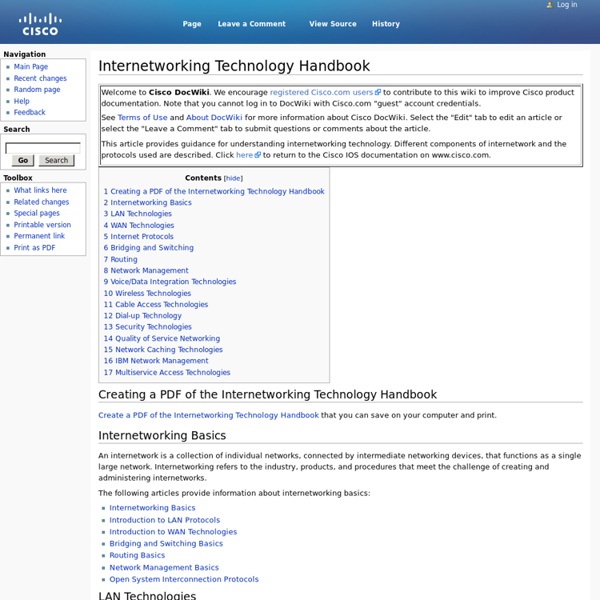ATM Traffic Management - Frequently Asked Questions [Cisco Port Adapters]
Table Of Contents Frequently Asked Questions General FAQs What types of queues are implemented on the Cisco 7200 series to support ATM traffic? What is the transmit ring and how does it work? What is the transmit ring limit and when should you tune it?
ABC RESEAU : Les bases pour comprendre et créer un réseau local
Cisco Technical Tips Conventions
Introduction This document describes the text, image, and command conventions used in Cisco technical tips. General Conventions Text Bold indicates text the user must enter or select, such as menu items, buttons, and commands. Alerts Tip Means the following information will help you solve a problem. Note Means reader take note. Caution Means reader be careful. Warning Warning means danger. The exit icon means you are leaving the Cisco website. Cisco IOS/CatOS Software Commands The following conventions for Cisco IOS® and CatOS commands are also used in the command reference guides. Configuration Examples Generic router names, hostnames, usernames, passwords, and IP addresses are used in configuration examples. Important Note: Do not use username cisco or password cisco in your configurations. Router names: RouterX, nasX, and so on.
Calculatrice IP
1. Présentation Cette calculatrice IP a pour but de faciliter la gestion des masques réseaux dans une infrastructure. L'autre partie de cette page vous permet, à partir de 2 adresses IP distinctes de calculer le masque réseau le plus petit contenant les 2 equipements, et vous affiche le masque réseau sous ses différentes formes. 2. Vous entrez un masque réseau et une IP et vous obtiendrez les différentes informations sur le réseau : le masque sous les autres format, les adresses de réseau et de broadcast... 3. Vous avez 2 adresses IP mais vous ne savez pas quel est le masque associé, avec ce formulaire, vous aurez le masque réseau le plus petit contenant les 2 adresses. 4. Cette calculatrice vous permet de savoir si une adresse IP fait partie du réseau précisé.
10 Windows 7 commands every administrator should know
Holiday rerun: An oldie-but-a-goodie, these command-line basics topped the list of popular troubleshooter posts last year. PC troubleshooting is becoming less common in larger organizations, but consultants and techs in smaller shops still have to get their hands dirty identifying and fixing desktop problems. Oftentimes, troubleshooting Windows 7 means delving into the command line. Before I begin... This article is intended solely as an introduction to some useful troubleshooting commands. 1: System File Checker Malicious software will often attempt to replace core system files with modified versions in an effort to take control of the system. sfc /scannow 2: File Signature Verification One way to verify the integrity of a system is to make sure that all the system files are digitally signed. sigverif 3: Driverquery Incorrect device drivers can lead to any number of system problems. driverquery If you need a bit more information, you can append the -v switch. driverquery -v driverquery -si
Tier 1 network
A tier 1 network is an Internet Protocol (IP) network that participates in the Internet solely via settlement-free interconnection, also known as settlement-free peering.[1] Definition[edit] Relationship between the various tiers on Internet providers There is no authority that defines tiers of networks participating in the Internet. By this definition, a tier 1 network is a transit-free network that peers with every other tier 1 network. The most widely quoted source for identifying tier 1 networks is published by Renesys Corporation,[3] but the base information to prove the claim is publicly accessible from many locations, such as the RIPE RIS database,[4] the Oregon Route Views servers, the Packet Clearing House, and others. It is difficult to determine whether a network is paying settlements when the business agreements are not public information, or are covered under a non-disclosure agreement. Strictly observing this definition of tier 1 networks would exclude every network.
CCNA1 Practice Final, Packet Tracer 6
Upload Watch Queue Queue Watch QueueQueue Loading... Watch Queue Queue __count__/__total__ danscourses.com danscourses Working... ► Play all CCNA1 Practice Final, Packet Tracer 6 by danscourses6 videos1,624 viewsLast updated on May 7, 2015 Play all Sign in to YouTube Sign in History Sign in to add this to Watch Later Add to Loading playlists...
Comprendre les différences entre la fibre Gpon, P2P, Active Ethernet, FTTLA
Comprendre les différences entre la fibre "FTTH Gpon", "FTTH P2P", "FTTH Active Ethernet" et "FTTLA"+ une synthèse des réponses des 4 grands FAI (France Telecom, SFR, Free et Bouygues Telecom) à la consultation publique de l'ARCEP concernant les modalités d’accès au FTTH en dehors des zones très denses. Chaque logement est raccordé avec sa propre fibre au "point de mutualisation". Ce dernier est situé en zone très dense dans un immeuble, en général au premier sous-sol. L'instauration d'un "point de mutualisation" par l'ARCEP a pour but d'éviter les excès qui ont eu lieu entre 2007 et 2009 où certains immeubles ont été fibrés intégralement par 4 opérateurs. Pour relier le point de mutualisation, il existe 3 technologies : Dans un réseau point-à-multipoint GPON (pour Gigabit Passive Optical Network) les signaux venant des fibres de plusieurs abonnés sont rassemblés par un diviseur/coupleur optique au sein d’une unique fibre reliée au central OLT (Optical Line Terminal).



